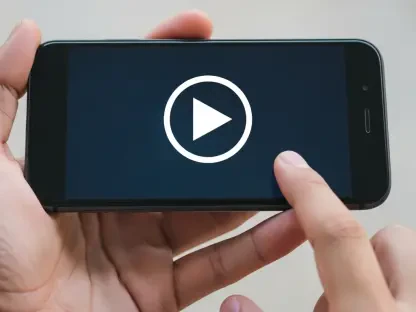In today’s fast-paced world of digital marketing, Anastasia Braitsik stands out as a global authority on SEO, content marketing, and data analytics. She brings her wealth of expertise to discuss the dynamic shifts in mobile app marketing, particularly focusing on the use of QR codes, visual strategies, and the future of app-based marketing. As mobile marketing becomes increasingly specific and user-focused, her insights shed light on the trends redefining how brands connect with their audiences.
How have QR codes transformed from a marketing gimmick to a tool driving real-world conversions?
QR codes have crossed over from being mere marketing curiosities to essential tools that foster real-world user engagement and conversions. They serve as a bridge between offline experiences and immediate digital actions, like app downloads or accessing exclusive deals. This transformation stems from their strategic placement in high-engagement contexts such as in-store signage or product packaging, making them highly effective in capturing consumer attention at the perfect moment. Their low friction and ease of use have turned them into powerful conduits for direct consumer interaction, transforming spontaneous offline interest into measurable mobile action.
What strategies can advertisers use to connect offline experiences with mobile actions using QR codes?
To effectively leverage QR codes, advertisers should focus on their strategic placement in highly interactive or consumer-dense locations. By embedding them in environments where consumers are already engaged and likely to act, businesses can facilitate seamless transitions from offline to online. For instance, placing QR codes in event spaces, retail aisles, or even within print advertisements can invite users to scan for promotions, app downloads, or additional content, fostering higher engagement and smoother customer experiences.
In what ways has niche visual targeting changed mobile app advertising?
Niche visual targeting has shifted the advertising paradigm from broad strokes to precision-driven engagements. It allows brands to tailor their visual content and messaging to resonate more deeply with distinct segments, such as specific lifestyles or user aspirations. This granularity ensures that the ads not only catch the eye but also connect emotionally with the viewer, resulting in higher user engagement and reduced ad fatigue, as they align closely with the audience’s personal interests and behaviors.
How can advertisers tailor visuals and messaging to appeal to specific psychographics rather than broad demographics?
Advertisers can delve into psychographics by understanding their audience’s values, interests, lifestyles, and motivations. By crafting visuals and messaging that speak directly to these underlying factors, ads can resonate on a more personal level, rather than merely skimming the surface with broad demographic data. This means developing creative content that mirrors the day-to-day life or aspirations of their target audience, whether that involves visual elements, cultural references, or contextually relevant scenarios.
How does using App Store and Google Play badges in app advertising build trust with potential users?
App Store and Google Play badges are potent symbols of credibility and security. These badges inherit the trust and reliability associated with these platforms, instinctively reassuring users that the app being advertised is legitimate and free from potential digital threats. By featuring these badges, advertisers are not only promoting their app but are also sending a clear and trusted signal that downloading the app is a secure and valuable action to take.
Why are App Store and Google Play badges considered a visual power move in app advertising?
These badges serve as a visual affirmation of an app’s authenticity and availability. In essence, they leverage the powerful reputations of the App Store and Google Play to boost the perceived legitimacy of the advertised app. This not only simplifies the user’s decision-making process but also enhances trust by visually aligning the app with well-known and respected app marketplaces, thereby effectively streamlining the path to download.
What is the role of educational and tutorial content in increasing user engagement and retention?
Educational and tutorial content plays a crucial role in helping users quickly understand an app’s functionalities and benefits, thereby reducing initial friction. By guiding users through essential features and offering them practical insights on how to integrate the app into their daily routines, this content fosters a sense of competence and satisfaction. This, in turn, enhances user retention as users are more likely to continue engaging with an app they can navigate and extract value from with ease.
How can apps effectively segment their users to provide tailored tutorial content?
Effectively segmenting users involves analyzing user behaviors and stages within their journey to provide targeted tutorial content. This can be achieved through data analytics, which tracks user interactions and preferences, allowing apps to deliver customized tutorials. By categorizing users as new, intermediate, or advanced, apps can offer personalized onboarding experiences or advanced feature demonstrations tailored to each group’s needs, thereby improving user satisfaction and retention.
What is the significance of creating a user journey with personalized content for new and power users?
Creating personalized user journeys enhances the overall experience by ensuring content and support are relevant to each user’s level of expertise. New users benefit significantly from induction-style tutorials that acclimate them to the app’s core features, while power users appreciate insights into advanced functionalities that enhance productivity. This not only encourages a deeper interaction with the app but also reinforces user loyalty as individuals feel valued and understood on a personal level.
How can niche ad targeting enhance engagement and reduce ad fatigue?
Niche ad targeting elevates user engagement by delivering content that resonates more personally with the audience’s specific interests and behaviors. By tapping into distinct user segments and avoiding generic messaging, brands can deliver ads that feel relevant and engaging. This tailored approach cuts through the clutter, ensuring ads are not only seen but acted upon, thus reducing the likelihood of ad fatigue as viewers feel better understood and less overwhelmed.
What are some examples of psychographic intent that advertisers can use to create more effective ads?
Psychographic intent encompasses lifestyle choices, values, and emotional triggers that drive user decisions. Advertisers can leverage these by crafting ads that align with users’ aspirations, such as showcasing a healthy lifestyle for fitness enthusiasts or presenting luxurious, relaxation-themed visuals for wellness seekers. By appealing to these deeper motivations, ads become more compelling, fostering meaningful connections with the audience and encouraging engagement.
How can advertisers leverage hyper-targeted interactions to drive app installs or content downloads through QR codes?
Advertisers can use hyper-targeted interactions by pinpointing ideal moments where consumers are not only receptive but inclined toward action. This involves strategically placing QR codes in settings or events that make app installation or content download an effortless, logical next step. By aligning the QR code’s call-to-action with the consumer’s immediate environment and interests, advertisers can create seamless transitions from offline experiences to mobile engagements.
What future strategies should brands consider to remain competitive in the evolving mobile app landscape?
Brands should consider investing in AI-powered personalization and advanced data analytics to enhance user experiences. This not only involves personalizing content recommendations but also optimizing in-app interactions to meet user preferences dynamically. Additionally, exploring cutting-edge technologies like augmented reality for immersive experiences and continuous testing to refine marketing strategies will be necessary to remain competitive and relevant as consumer expectations evolve.









